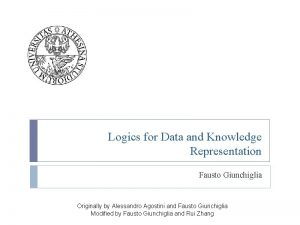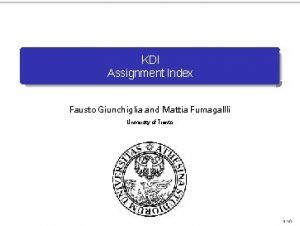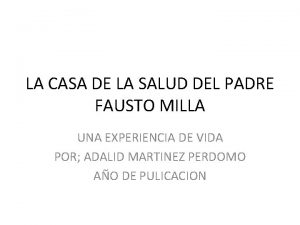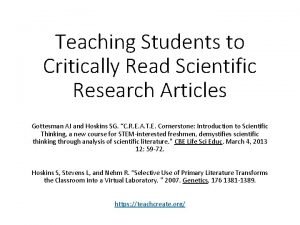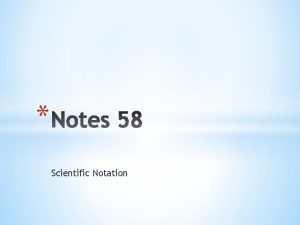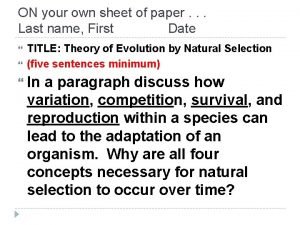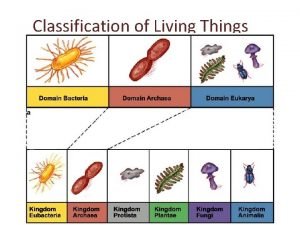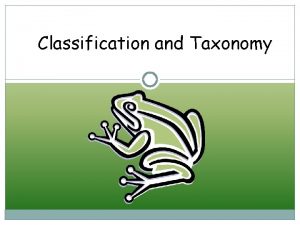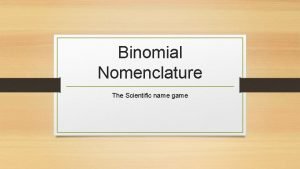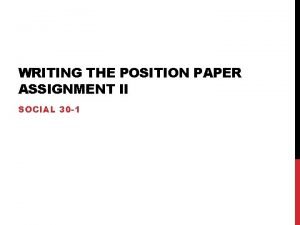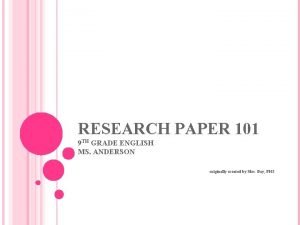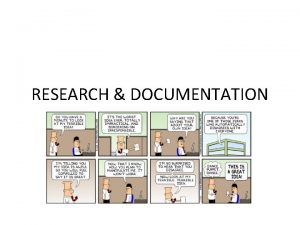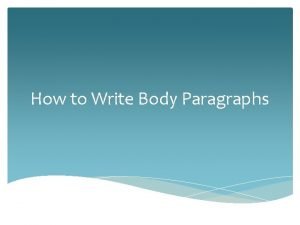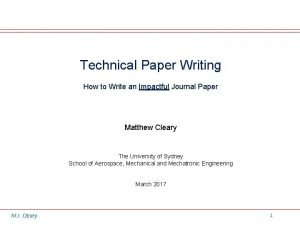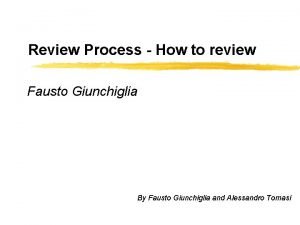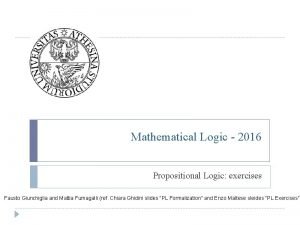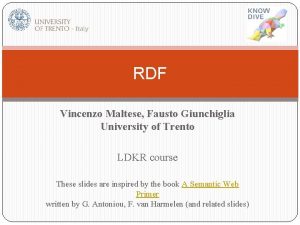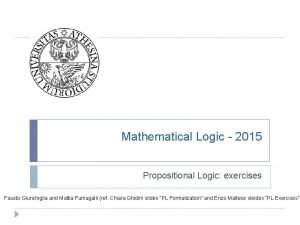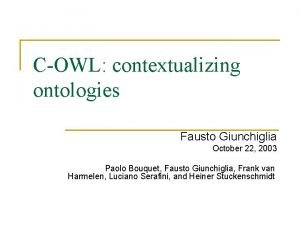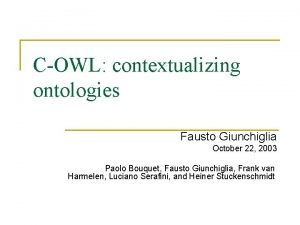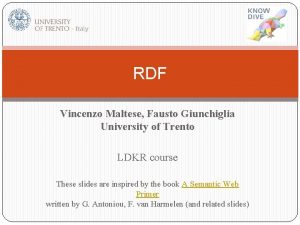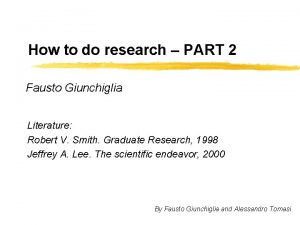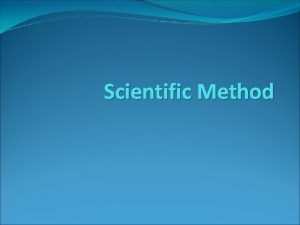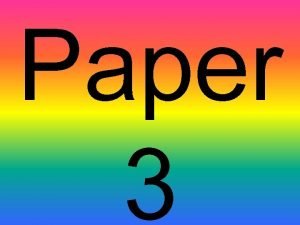How to write a scientific paper Fausto Giunchiglia






























![5. Structuring Papers 3. Introduction C 1. [Context + to get the idea] 1 5. Structuring Papers 3. Introduction C 1. [Context + to get the idea] 1](https://slidetodoc.com/presentation_image_h2/7c337318ecd7a59e03066e7f8a9d60f6/image-31.jpg)
- Slides: 31

How to write a scientific paper Fausto Giunchiglia Literature: Jeffrey A. Lee, The scientific endeavor, 2000 Bruno Buchberger, Thinking Speaking Writing By Fausto Giunchiglia and Alessandro Tomasi

Index: 1. Role of Papers 2. Analysis of audience 3. Analysis of kind of paper 4. Defining Goals 5. Structuring Papers 6. The Process 7. Style

1. Role of Papers

1. Role of Papers “I have got the idea but I cannot express it” This is nonsense

1. Role of Papers Role of parts of Papers: • support the process of expressing an idea • show your result • relate to existing scientific work • enable readers to learn / continue their work

2. Analysis of audience

2. Analysis of audience “First I’ll write the paper and then I’ll publish it” This is nonsense

2. Analysis of audience Depends on the audience: • Age • Scholarship • Background • Scientific Community

3. Analysis of kind of papers

3. Analysis of kind of papers 1. Tech. Rep 2. Workshop Paper 3. Top Conference 4. Journal 5. Invited Talks

3. Analysis of kind of papers Kind of publications • archival publications • not archival publications • ISBN/ISSN publications

2. Analysis of kind of papers It’s the writer’s business to make the reader’s life as easy as possible

2. Analysis of kind of papers A Paper must be: • Self-Explanatory • Self-Contained

2. Analysis of kind of papers To plan long in advance is the difference from accepting and rejecting 3 months [for a PHD student] Decide which conference to submit the paper 3… 6 months [for a PHD Student] Write it Deadline of a Conference

4. Defining Goals

4. Defining Goals The process from Analysis to Synthesis Until you have written a paper, the research is not finished

4. Defining Goals One paper one message Ask yourself: • What is your goal? (a new technique, a new experimentation) • What did you try to do? • What have you done? • How did you do this? • What is the core idea?

4. Defining Goals Message = Core Idea = Goal • A goal may be a sub-goal of another goal • A goal may be a prerequisite for another goal

5. Structuring Papers

5. Structuring Papers After defining your goal, you can start working on the structure of the paper 5. 1 Coarse Grained 5. 2 Fine Grained

5. Structuring Papers Do the Writing according to the following Sequence 1. Tentative Title A 2. Write your Main Idea D 3. Write Introduction C 4. Write Conclusions E 5. Finalize the Title A 6. Write the Abstract B

5. Structuring Papers 1. Title A 2. Abstract B 3. Introduction C 4. Work out of main idea 5. Details of main idea D 6. Conclusions E 7. Appendixes F

5. Structuring Papers In Title, Abstract, Introduction, Conclusions - same thing at different levels of detail - different purposes

5. Structuring Papers 1. Title: A short sentence with the description of your work 3 -5 words Goal: convince reader to read abstract A

5. Structuring Papers 1. Title Structure: 1. Name of the problem solved 2. Data Domain 3. Solution A

5. Structuring Papers 1. Title Structure: Example 1. Data Domain Data Coordination in Peer-to-Peer Data. Base 2. Name of the problem to be solved: 3. Peer-to-Peer Data. Base 3. Solution: 4. Semantic Matching in Heterogeneous DB’s A

5. Structuring Papers 1. Title Structure: how to find a title A table with problems, solutions and domains: Problems Solutions Domain Heterogenity DB Matching P 2 P Database … Semantic Matching Bioinformatics … Title is a combinations of this words… … A

5. Structuring Papers 2. Abstract A paragraph with the description of your work 10 lines Goal: convince reader to read the paper B

5. Structuring Papers 2. Abstract Components 1. Name of the Problem Solved 2. Data Domain 3. Solution 4. What is new 5. NO CITATIONS B

5. Structuring Papers 3. Introduction Some paragraph with the set of goals of your work 1 page Goal: establish main message of paper C
![5 Structuring Papers 3 Introduction C 1 Context to get the idea 1 5. Structuring Papers 3. Introduction C 1. [Context + to get the idea] 1](https://slidetodoc.com/presentation_image_h2/7c337318ecd7a59e03066e7f8a9d60f6/image-31.jpg)
5. Structuring Papers 3. Introduction C 1. [Context + to get the idea] 1 paragraph (NO citations) 2. Problem + Citations ≤ 20 lines 3. Approach + Solutions ≤ 20 lines 4. [Why you are novel] 5. Structure of the Paper, by sections ≤ 20 lines 6. [Auxiliary Material (Notations, 7. Observations, How to read it, …)]
 Fausto giunchiglia
Fausto giunchiglia Fausto giunchiglia
Fausto giunchiglia Fausto giunchiglia
Fausto giunchiglia Fausto veranzio parachute
Fausto veranzio parachute Many dvi sielos grumias nuolatos
Many dvi sielos grumias nuolatos Esquema de fausto
Esquema de fausto Ing. segundo fausto roncal vergara
Ing. segundo fausto roncal vergara Fausto e almeida
Fausto e almeida Padre fausto
Padre fausto Fausto catena
Fausto catena Scientific inquiry vs scientific method
Scientific inquiry vs scientific method How is a scientific law different from a scientific theory?
How is a scientific law different from a scientific theory? Scientific white paper
Scientific white paper Absorbency of paper towels experiment
Absorbency of paper towels experiment Scientific paper
Scientific paper Paper 2 aice general paper
Paper 2 aice general paper Aice general paper prompts
Aice general paper prompts How scientific names are written
How scientific names are written Vocabulary for scientific notation
Vocabulary for scientific notation Plant classes taxonomy
Plant classes taxonomy Genus and species names
Genus and species names Taxonomy arrangement
Taxonomy arrangement Animalia plantae
Animalia plantae How to write species name
How to write species name Scientific name of game
Scientific name of game Position paper assignment
Position paper assignment How to write an a+ research paper keystone
How to write an a+ research paper keystone Research documentation example
Research documentation example Body paragraph formula
Body paragraph formula How to write discussion in research paper
How to write discussion in research paper How to write a career research paper
How to write a career research paper How to write a technical paper
How to write a technical paper
